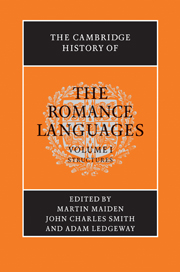Book contents
- Frontmatter
- Introduction
- 1 ROMANCE LINGUISTICS AND HISTORICAL LINGUISTICS: REFLECTIONS ON SYNCHRONY AND DIACHRONY
- 2 SYLLABLE, SEGMENT AND PROSODY
- 3 PHONOLOGICAL PROCESSES
- 4 MORPHOLOGICAL PERSISTENCE
- 5 MORPHOPHONOLOGICAL INNOVATION
- 6 CHANGE AND CONTINUITY IN FORM–FUNCTION RELATIONSHIPS
- 7 MORPHOSYNTACTIC PERSISTENCE
- 8 SYNTACTIC AND MORPHOSYNTACTIC TYPOLOGY AND CHANGE
- 9 PRAGMATIC AND DISCOURSE CHANGES
- 10 WORD FORMATION
- 11 LEXICAL STABILITY
- 12 LEXICAL CHANGE
- 13 LATIN AND THE STRUCTURE OF WRITTEN ROMANCE
- 14 SLANG AND JARGONS
- Notes
- References and bibliographical abbreviations
- Index
1 - ROMANCE LINGUISTICS AND HISTORICAL LINGUISTICS: REFLECTIONS ON SYNCHRONY AND DIACHRONY
Published online by Cambridge University Press: 28 May 2011
- Frontmatter
- Introduction
- 1 ROMANCE LINGUISTICS AND HISTORICAL LINGUISTICS: REFLECTIONS ON SYNCHRONY AND DIACHRONY
- 2 SYLLABLE, SEGMENT AND PROSODY
- 3 PHONOLOGICAL PROCESSES
- 4 MORPHOLOGICAL PERSISTENCE
- 5 MORPHOPHONOLOGICAL INNOVATION
- 6 CHANGE AND CONTINUITY IN FORM–FUNCTION RELATIONSHIPS
- 7 MORPHOSYNTACTIC PERSISTENCE
- 8 SYNTACTIC AND MORPHOSYNTACTIC TYPOLOGY AND CHANGE
- 9 PRAGMATIC AND DISCOURSE CHANGES
- 10 WORD FORMATION
- 11 LEXICAL STABILITY
- 12 LEXICAL CHANGE
- 13 LATIN AND THE STRUCTURE OF WRITTEN ROMANCE
- 14 SLANG AND JARGONS
- Notes
- References and bibliographical abbreviations
- Index
Summary
In remembrance of Eugenio Coseriu, József Herman, Yakov Malkiel
Introduction
I discuss here some problems of Romance diachronic morphosyntax in the light of theoretical and methodological considerations on the relation between diachrony and synchrony, and the question of linguistic change.
I first attempt to demonstrate a thesis that is perhaps not obvious, and rather goes against the grain of contemporary thinking: Romance linguistics has rather more to offer general linguistics in its thinking on the synchrony–diachrony relationship and the problem of language change than contemporary general linguistics has to offer Romance linguistics. Our discipline not only possesses an extraordinary stock of data, but also has long had a rich array of methodological and theoretical tools, which make it a particularly ideal platform for tackling the intellectual problem of diachrony. Romance linguistics foresaw aspects of the modern debate, and in some respects offered solutions ahead of that debate. In particular I shall be concerned with the following issues:
(a) ‘Laws’: are there laws of transformation through time, besides laws of analogy? In other words, do diachronic structures exist, in addition to synchronic ones?
(b) The form–function relation: does this relation have the same properties in diachrony as in synchrony?
(c) Syntactic factors in morphosyntactic change: is their role active or inert?
Between general and Romance linguistics
Introduction
Are the power and potential of Romance diachronic linguistics obvious?
- Type
- Chapter
- Information
- The Cambridge History of the Romance Languages , pp. 1 - 49Publisher: Cambridge University PressPrint publication year: 2010
- 2
- Cited by



